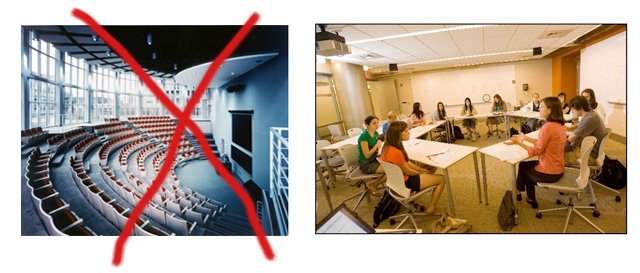The New York Times today reports “At M.I.T., Large Lectures Are Going the Way of the Blackboard”. Introductory physics courses are now taught in smaller classes that emphasize hands-on, interactive, collaborative learning rather than the traditional large lecture course. Students initially petitioned against this change, but attendance has increased and the failure rate has dropped. Lectures are reduced to brief presentations, and then students work on concepts in small groups, with the help of the instructor, teaching assistants, and large white boards.
Harvard’s Dr. Eric Mazur explains the problem with lecture-based courses: “The people who wanted to understand, had the discipline, the urge, to sit down afterwards and say, ‘Let me figure this out.’ ” But for the majority, he said, a different approach is needed.
Perhaps the NY Times doesn’t travel south very often. Here at Duke, many faculty have long implemented these sorts of ‘active learning‘ strategies. For example:
- The Link (teaching and learning space in Perkins Library) exists in part to provide the kinds of flexible spaces and technologies that allow faculty to fully explore these teaching approaches.
- Faculty in Electrical and Computer Engineering at the Pratt School of Engineering have redesigned the curriculum to provide hands-on experience with engineering skills from the very first course.
- Dr. Caroline Bruzelius teaches a course on Gothic Cathedrals by having students design cathedrals; she has written about her course here and here.
- In Engineering and Computer Science, faculty have used tablet PCs to provide students with active learning, including group problem solving in their courses.
- Our center, the Center for Instructional Technology, continues to provide help and resources (not to mention workshops) for faculty, including ideas for adding active learning activities and approaches to their courses. Last semester, we completed a fellows program with faculty teaching in the Link, and will continue to support faculty innovation.

Our neighbors at NCSU have been using hands-on, active learning rather than simply lecturing for years. Richard Felder incorporates active learning in his large lecture classes, providing research reports of his positive results. He also provides resources to help other faculty. Dr. Robert Beichner redesigned physics courses to incorporate active learning, providing guidelines that are now a national model (SCALE-UP).
While you are at the New York Times, enjoy today’s slide show of great underwater images.
This entry was written by Shawn Miller and Andrea Novicki
